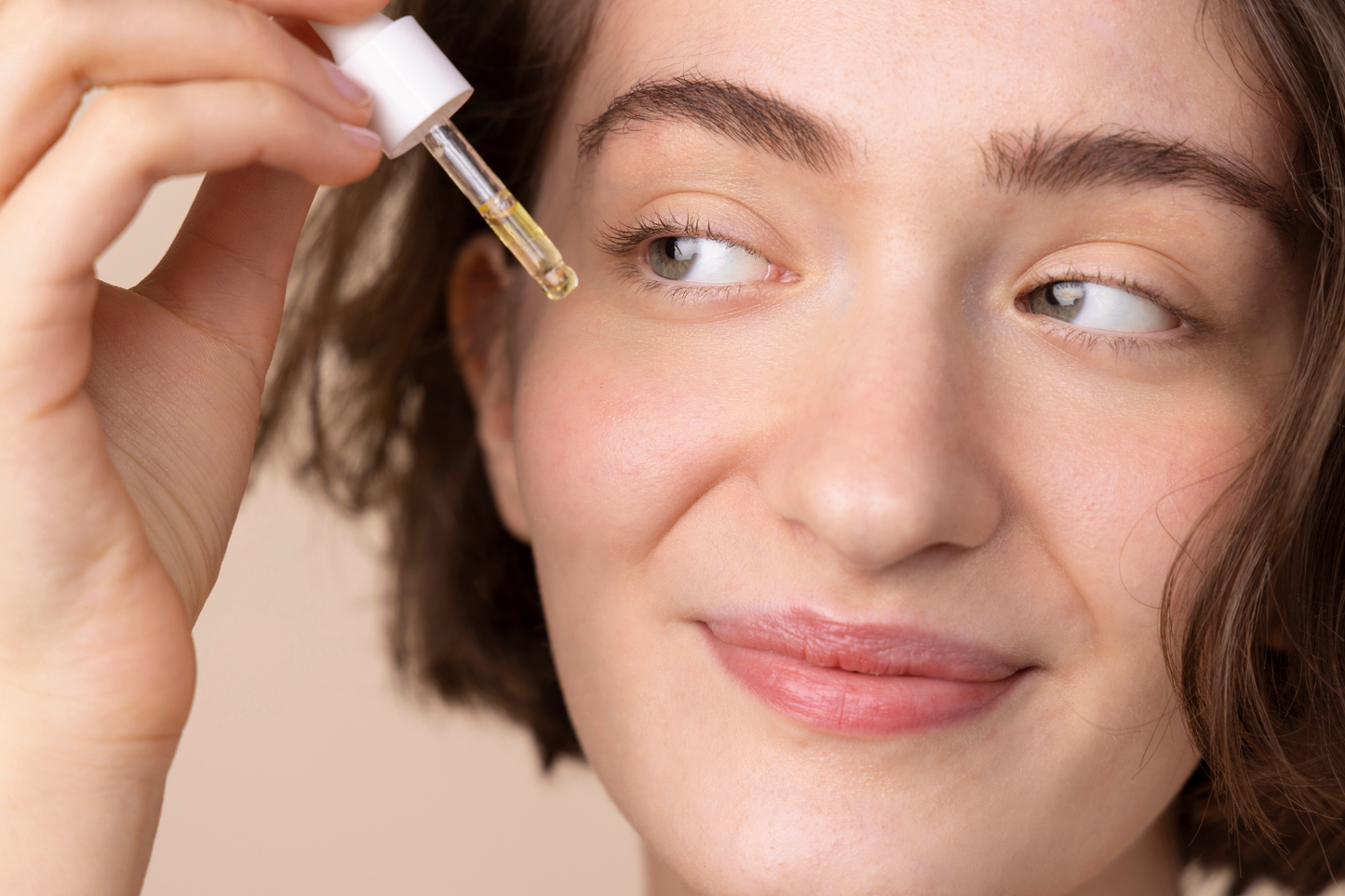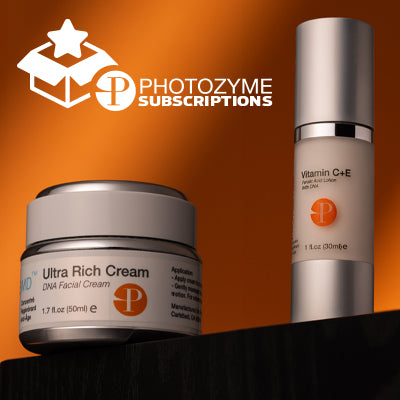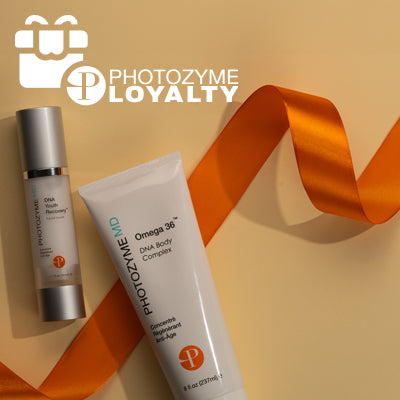
Learn whether you can use hyaluronic acid with retinol. Here's the science, safe usage tips, and how this duo improves your skincare routine with Photozyme.
Key Takeaways:
- Dual Benefits For Hydration & Anti-Aging: Combining hyaluronic acid with retinol provides enhanced hydration, improved skin tolerance, and boosted anti-aging benefits, making it a powerful addition to any skincare routine.
- Start Gradually To Minimize Irritation: While the combination can be beneficial, it is essential to introduce these ingredients carefully to avoid potential irritation, especially for those new to retinol or with sensitive skin.
- Tailor To Skin Type For Optimal Results: Customizing formulations and adapting application methods according to individual skin types maximizes the advantages of hyaluronic acid and retinol without compromising skin health.
Timing and compatibility matter if you’re layering products like retinol and hyaluronic acid. These two active ingredients serve distinct functions: one encourages cellular turnover, the other supports hydration and barrier integrity. But how do they interact, and does combining them improve results or increase risk? Understanding whether you can use hyaluronic acid with retinol is critical to building a regimen that delivers clinical-grade results without triggering irritation or imbalance.
At Photozyme, we operate at the intersection of dermatological science and cellular precision. Every formula is powered by patented DNA repair enzymes and guided by peer-reviewed research, not trend cycles. Developed for clinical performance and trusted by professionals, Photozyme formulations deliver measurable results at a molecular level, supporting long-term skin health, resilience, and visible transformation. This is a bioactive intervention backed by science.
In this blog, we will explore the individual functions of hyaluronic acid and retinol, how their combined use affects skin physiology, best practices for layering them safely, and formulation strategies that support hydration while minimizing retinoid-related irritation.
Core Benefits Of Pairing Hyaluronic Acid With Retinol
Combining hyaluronic acid with retinol in your skincare routine offers a range of science-backed advantages that support healthier, more resilient skin.
Here’s how their synergy can enhance your results:
1. Enhanced Hydration
Retinol is renowned for its effectiveness in stimulating cellular turnover and diminishing fine lines, but it can also lead to dryness or irritation, especially when first introduced. Hyaluronic acid acts as a potent humectant, binding water to the skin and offsetting the potential dehydration caused by retinol. This coupling allows you to experience the full benefits of retinol while maintaining an optimal moisture balance.
2. Improved Skin Tolerance
For many, initial use of retinol comes with side effects like flaking or sensitivity. Hyaluronic acid helps soothe and reinforce the skin barrier, making your complexion more resilient and reducing common retinol-related discomfort. By layering hyaluronic acid before or after applying retinol, you foster a gentler introduction of this powerful ingredient to your regimen.
3. Boosted Anti-Aging Results
Pairing hyaluronic acid’s plumping effect with retinol’s ability to accelerate cell renewal delivers a comprehensive anti-aging approach. Together, they visibly reduce the appearance of fine lines, promote a smoother skin texture, and restore youthful firmness.
4. Support For All Skin Types
Whether your skin is oily, dry, or sensitive, combining hyaluronic acid and retinol is clinically proven to be compatible and beneficial. Their distinct mechanisms of action cater to your unique skin needs without exacerbating common concerns like breakouts, redness, or excessive dryness.
5. Maximized Brightness And Even Tone
Regular use enhances skin luminosity and helps diminish visible hyperpigmentation or sun spots. While retinol works to even out pigmentation at a deeper level, hyaluronic acid ensures ongoing hydration to support a radiant, healthy appearance.
Potential Risks When Mixing The Two Actives
When considering whether to use hyaluronic acid with retinol, it's essential to recognize how each ingredient interacts with your skin and the other. While both actives offer significant benefits, combining them is not entirely without risks.
- Initial Retinol Reactions Are Common: Retinol accelerates epidermal turnover, which can initially cause dryness, peeling, and irritation. Introducing other actives, regardless of their gentleness, during this period can compound these effects, especially in retinol-naïve or sensitive skin.
- Skin Barrier Disruption From Overlayering: Layering hyaluronic acid with retinol before the skin has adjusted may overload the barrier. This often results in compromised hydration levels, redness, and decreased tolerance to both environmental and product-based stimuli.
- Hydration Isn’t Always Protective: Although hyaluronic acid is hydrating, misusing it or using it in a poorly formulated product can pull moisture from deeper skin layers in dry environments, potentially increasing transepidermal water loss when paired with retinoids.
- Sensitivity Signals Barrier Stress: Persistent stinging, redness, or flaking after layering these actives may signal that the skin barrier needs recovery. In such cases, reduce usage frequency and reintroduce products with greater spacing between applications.
- Incompatibility With Other Actives: Adding additional treatments like exfoliating acids or vitamin C to a routine already combining hyaluronic acid and retinol can overwhelm skin. This misstep heightens the risk of inflammation, irritation, and overall barrier dysfunction.
- Application Order & Timing Matter: Incorrect sequencing, such as applying retinol to damp skin or skipping a barrier-reinforcing moisturizer, can amplify irritation. Skin should be dry, and follow-up hydration should always support retinol use.
- Preexisting Skin Conditions Require Caution: Those with eczema, rosacea, or barrier impairment may react negatively when combining these ingredients. A dermatologist-guided regimen is essential to avoid flares or prolonged irritation in vulnerable skin types.
- Not Recommended For Pregnant Or Breastfeeding Patients: Retinol is contraindicated during pregnancy and lactation. Unless a medical provider clears, patients should avoid topical retinoids entirely, even when buffered with hydrating agents like hyaluronic acid.
Layering Tips For Sensitive Or Compromised Skin Barriers
If your skin is sensitive, reactive, or has a compromised barrier, often reflected through redness, stinging, or persistent dryness, a thoughtful approach to layering hyaluronic acid with retinol is essential. The goal is to provide moisture support, minimize irritation, and maximize the benefits of both ingredients without overwhelming your skin.
Begin With A Non-Stripping Cleanser
Start by cleansing with a gentle, non-foaming cleanser that won’t strip away natural oils.
Apply Hyaluronic Acid Immediately After Cleansing
Immediately after patting your face dry, apply a serum containing hyaluronic acid. This step draws in moisture and builds a cushion of hydration, which helps buffer the skin against potential dryness from retinol.
Use A Barrier Repair Cream Before Retinol
Allow the hyaluronic acid to fully absorb before moving to the next layer. If your product routine includes an emollient barrier repair cream, this is the right time to apply it. Such creams support the skin’s natural defense systems, sealing in the hydration provided by hyaluronic acid.
Start With A Low-Concentration Retinol
When using retinol, pick a lower concentration, especially if you’re new to the ingredient or experiencing irritation. Apply retinol only after your hydrators have settled. Consider limiting use to once or twice a week at first, gradually increasing frequency as your skin adapts.
Watch For Signs Of Sensitivity
Monitor your skin closely for changes in texture, tightness, or discomfort. If you notice excessive peeling or sensitivity, scale back on either frequency or concentration. Additionally, always wear broad-spectrum SPF during the day, as retinol and compromised barriers increase susceptibility to sun damage.
Avoid Competing Actives On Retinol Nights
Patch testing new products and avoiding exfoliators or actives like AHAs and BHAs on the same nights as retinol can help prevent overstimulation. This careful, methodical layering approach can allow you to safely benefit from hyaluronic acid and retinol, even with a sensitive or compromised skin barrier.
How Different Skin Types React To This Duo
When combining hyaluronic acid with retinol, individual skin types may experience distinct benefits and challenges. Understanding how your skin might respond ensures a smoother transition and maximizes the positive effects of each ingredient.
Oily Or Acne-Prone Skin
Incorporating hyaluronic acid alongside retinol can be particularly effective if your skin tends to be oily or prone to breakouts. Retinol’s ability to regulate oil production and promote cell turnover is well-documented, but this can sometimes result in dryness or irritation. Hyaluronic acid addresses this by replenishing hydration, helping to minimize flakiness and reduce the risk of skin barrier disruption. Selecting non-comedogenic formulas is crucial for those susceptible to clogged pores to avoid triggering blemishes.
Dry Or Dehydrated Skin
Dry skin often reacts sensitively to retinoids, sometimes manifesting as redness, peeling, or tightness. Hyaluronic acid provides an immediate infusion of moisture, enhancing comfort and supporting the skin’s barrier as it acclimates to retinol. This one-two approach leaves skin feeling hydrated and less prone to the common side effects associated with retinol.
Sensitive Skin
Pairing hyaluronic acid with retinol for sensitive skin can help buffer potential irritation. Hyaluronic acid’s gentle, soothing hydration counters the drying effects and encourages tolerance. However, applying these ingredients staggered or using retinol at lower concentrations may be beneficial at the onset. Gradually build up retinol use while continuing with hyaluronic acid to fortify and support the skin’s resilience.
Combination Skin
Combination skin types, those experiencing both oily and dry zones, often benefit from the balanced approach these two ingredients provide. Retinol refines skin texture and addresses uneven tone, while hyaluronic acid ensures that even your driest areas remain comfortably hydrated. Adapting application methods, such as layering serums strategically, maximizes benefits across all facial zones without overburdening the skin.
Mature Or Aging Skin
Mature skin naturally experiences a decrease in hydration and slower cell turnover. Retinol and hyaluronic acid synergy is particularly beneficial here, with retinol encouraging collagen synthesis and cellular renewal, and hyaluronic acid restoring plumpness and elasticity. This pairing visibly reduces the appearance of fine lines and supports a firmer, brighter complexion over time.
Signs Your Skin Is Thriving Or Struggling With The Combo
Combining hyaluronic acid with retinol offers science-backed benefits, but your skin’s response can vary. Tuning into these reactions is key to adjusting your routine for optimal results.
Positive Signs Of Compatibility
When your skin thrives with the combination, you'll notice increased suppleness and hydration. Fine lines may appear softened, and overall texture can become smoother. The complexion might look brighter, reflecting improved moisture retention and effective renewal, hallmarks of skin that tolerates both ingredients well. Reduced dry patches and a comfortable, plump sensation are additional signals you’re on the right track.
Red Flags To Watch For
On the other hand, your skin may struggle if the pairing is not suited to your tolerance or application method. Common warning signs include persistent redness, irritation, or stinging, especially after applying retinol. Flaking, tightness, or visible peeling are indications that your skin barrier needs extra care. Some individuals might experience breakouts or a sudden increase in sensitivity. These reactions suggest adjusting frequency, layering with extra hydration, or consulting a professional for guidance.
Final Thoughts
The answer to “Can you use hyaluronic acid with retinol?” is a definitive yes. Combining these powerhouse ingredients supports your skin’s resilience and vitality. Hyaluronic acid excels at delivering and retaining hydration, making it an ideal partner to retinol, which can sometimes cause dryness or irritation, especially as your skin adjusts.
At Photozyme, our philosophy is evidence-based, so every formulation is designed to protect your skin, restore youthfulness, and address environmental stressors at the cellular level using advanced DNA repair enzymes.
Consistency and attention to skin tolerance are crucial. If you’re seeking comprehensive solutions for aging or sun-damaged skin, leveraging these two active ingredients together delivers clinically validated and trusted results for all skin types, including the most sensitive.
Read also:
- How To Layer Hyaluronic Acid And Retinol For Maximum Results
- Retinol Or Hyaluronic Acid First? The Right Skincare Order Explained
- Retinal vs. Retinol: Which One Is Right For Your Skin?
Frequently Asked Questions About Can You Use Hyaluronic Acid With Retinol
Is it safe to layer hyaluronic acid with retinol?
Yes, it is safe to layer hyaluronic acid with retinol. Both ingredients are well-tolerated by most skin types, and combining them can enhance your skincare routine. At Photozyme, we focus on science-backed formulations that integrate seamlessly with both of these ingredients, ensuring compatibility and minimizing the risk of irritation.
What are the benefits of using hyaluronic acid and retinol?
When used together, hyaluronic acid and retinol offer comprehensive benefits. Retinol accelerates cell turnover, targeting fine lines, wrinkles, and sun damage, while hyaluronic acid deeply hydrates and supports the skin barrier. This combination can visibly improve firmness, brightness, and overall skin resilience, an effect you’ll often notice when introducing clinically validated, anti-aging solutions like those from Photozyme MD.
Should I apply hyaluronic acid before or after retinol?
Apply hyaluronic acid after retinol. Retinol works best on clean, dry skin; follow it with hyaluronic acid to seal in moisture and soothe potential dryness. This order ensures you maximize retinol’s efficacy while supporting your skin’s hydration levels, especially when using active, dermatologist-recommended products like ours.
Can hyaluronic acid make retinol more effective?
Hyaluronic acid doesn’t directly increase retinol’s potency, but it does make retinol use more tolerable by improving skin hydration. Well-hydrated skin can better withstand active ingredients and remain resilient, creating an optimal environment for retinol to deliver visible improvements—something we prioritize in every Photozyme MD formula.
Does hyaluronic acid reduce retinol irritation?
Yes, hyaluronic acid can help reduce retinol-related irritation. Reinforcing the skin barrier and replenishing hydration minimizes dryness and flaking, which are common side effects of retinol. This is particularly important when integrating advanced anti-aging products for sensitive skin types.
Will hyaluronic acid deactivate retinol?
No, hyaluronic acid will not deactivate retinol. These ingredients are chemically compatible and can be used together without diminishing each other's effectiveness. You can trust that layering these ingredients, especially in a regimen backed by science and recommended by dermatologists, supports your skin health without compromise.





